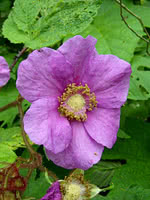Mon-Fri 9am - 5pm Mountain time
Flowering Raspberry vs Nodding Onion
Allium cernuum
Rubus odoratus
NOT AVAILABLE THIS SEASON - MIGHT RETURN
NOT AVAILABLE THIS SEASON - MIGHT RETURN
Nodding Onion is a native perennial wildflower known for its nodding clusters of flowers that range in color from white to pink to purple. The lightly scented blooms provide pollen and nectar for pollinators, especially bees, which can collect while hanging upside down, a capability most other insects lack.
The narrow, grass-like leaves of the Nodding Onion can be used as a seasoning in cooked dishes, though bulbs and raw leaves should not be eaten in large quantities. All parts of the plant have an onion-like aroma when bruised, which helps deter deer and rabbits. They can self-seed readily, so removing spent blooms helps manage their spread. Tolerant of a range of soils, including alkaline, it is well-suited for a variety of plantings, including pollinator gardens and naturalization projects.
The Flowering Raspberry is an ornamental shrubby plant that blooms with fragrant light purple flowers throughout the summer and has a large, decorative foliage of bright green leaves. The flowers resemble that of a wildrose, and the foliage turns a bright yellow in the fall. This cultivar produces small red raspberries, similar to that of a thimbleberry, but the fruit is mostly tasteless.
The Flowering Raspberry, also known as Virginia Raspberry or Purple-Flowered Raspberry, makes a great hedge plant and is a good choice for attracting birds to your yard.
Nodding Onion Quick Facts
Flowering Raspberry Quick Facts
Toxicity: raw leaves and bulbs can be midly toxic

